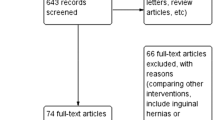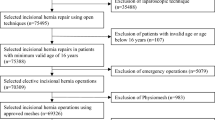Abstract
Purpose
Abdominal surgeries are common surgical procedures worldwide. Incisional hernias commonly develop after abdominal wall surgery. Surgery is the definite treatment for most incisional hernias but carries a higher rate of complications. Although frequently used, the real benefit of using drain tubes to reduce surgical complications after incisional hernia repair is uncertain.
Methods
PubMed and Embase databases were searched for studies that compared the outcomes of drain vs. no-drain placement and the risk of complications in patients undergoing incisional hernia repair. Primary endpoints were infection, seroma formation, length of hospital stay, and readmission rate.
Results
From a total of 771 studies, we included 2 RCTs and 4 non-RCTs. A total of 40,325 patients were included, of which 28 497 (71%) patients used drain tubes, and 11 828 (29%) had no drains. The drain group had a significantly higher infection rate (OR 1.89; CI 1.13–3.16; P = 0.01) and mean length of hospital stay (Mean Difference—MD 2.66; 95% CI 0.81–4.52; P = 0.005). There was no difference in seroma formation and the readmission rate.
Conclusion
This comprehensive systematic meta-analysis concluded that drain tube placement after incisional hernia repair is associated with increased infection rate and length of hospital stay without affecting the rate of seroma formation and readmission rate. Prospective randomized studies are required to confirm these findings.






Similar content being viewed by others
References
Berrevoet F (2018) Prevention of incisional hernias after open abdomen treatment. Front Surg 5:11. https://doi.org/10.3389/fsurg.2018.00011
Hope WW, Tuma F (2023) Incisional hernia. In: StatPearls [Internet]. StatPearls Publishing, Treasure Island, FL. https://www.ncbi.nlm.nih.gov/books/NBK435995/. Accessed 12 Jun 2023
den Hartog D, Dur AH, Tuinebreijer WE, Kreis RW (2008) Open surgical procedures for incisional hernias. Cochrane Database Syst Rev 2008(1):CD006438. https://doi.org/10.1002/14651858.cd006438.pub2
White TJ, Santos MC, Thompson JS (1998) Factors affecting wound complications in repair of ventral hernias. Am Surg 64:276–280
Gurusamy KS, Allen VB et al (2013) Wound drains after incisional hernia repair. Cochrane Database Syst Rev (12):CD005570. https://doi.org/10.1002/14651858.CD005570
Luo Y, Mohammed Jinnaah S, Masood D, Hodgson R (2020) Drain tube use in incisional hernia repair: a national survey. Hernia 25(2):427–433. https://doi.org/10.1007/s10029-019-02115-3
Wysocki AP, McGowan B (2018) To drain or not to drain: Supreme Court has the answer. ANZ J Surg 88(1–2):115. https://doi.org/10.1111/ans.14285
Louis V, Diab S, Villemin A, Brigand C, Manfredelli S, Delhorme JB, Rohr S, Romain B (2023) Do surgical drains reduce surgical site occurrence and infection after incisional hernia repair with sublay mesh? A non-randomised pilot study. Hernia 27(4):873–881. https://doi.org/10.1007/s10029-023-02768-1
Westphalen AP, Araújo ACF, Zacharias P, Rodrigues ES, Fracaro GB, Lopes Filho GDJ (2015) Repair of large incisional hernias. To drain or not to drain. Randomized clinical trial. Acta Cir Bras 30(12):844–851. https://doi.org/10.1590/s0102-865020150120000009
Willemin M, Schaffer C, Kefleyesus A, Dayer A, Demartines N, Schäfer M, Allemann P (2022) Drain versus no drain in open mesh repair for incisional hernia, results of a prospective randomized controlled trial. World J Surg 47(2):461–468. https://doi.org/10.1007/s00268-022-06725-4
Luo Y, Masood D, Mohammed Jinnaah S, Tacey M, Hodgson R (2020) Do drain tubes help reduce risks of post-operative complications in complex incisional hernia repair (as defined by a recent court ruling)? ANZ J Surg 90(6):1080–1085. https://doi.org/10.1111/ans.15875
Tejerizo JBT, Bartoli JD, Dreizzen E (2021) Utilidad del drenaje en las eventroplastias con malla. Rev Hispanoam Hernia 9(1):10–14. ISSN-e 2255-2677. https://doi.org/10.20960/rhh.00277
Page MJ, McKenzie JE, Bossuyt PM et al (2021) The PRISMA 2020 statement: an updated guideline for reporting systematic reviews. BMJ. https://doi.org/10.1136/bmj.n71
Sterne JAC, Savović J, Page MJ et al (2019) RoB 2: a revised tool for assessing risk of bias in randomized trials. BMJ 366:l4898. https://doi.org/10.1136/bmj.l4898
Sterne JA, Hernán MA, Reeves BC et al (2016) ROBINS-I: a tool for assessing risk of bias in non-randomized studies of interventions. BMJ 355:i4919. https://doi.org/10.1136/bmj.i4919
Miller BT, Tamer R, Petro CC et al (2023) Retromuscular drain versus no drain in robotic retromuscular ventral hernia repair: a propensity score-matched analysis of the abdominal core health quality collaborative. Hernia 27:409–413. https://doi.org/10.1007/s10029-022-02696-6
Sahm M, Pross M, Hukauf M, Adolf D, Köckerling F, Mantke R (2023) Drain versus no drain in elective open incisional hernia operations: a registry-based analysis with 39,523 patients. Hernia. https://doi.org/10.1007/s10029-023-02862-4
Funding
There was no funding for research and publication of this project.
Author information
Authors and Affiliations
Corresponding author
Ethics declarations
Conflict of interest
Dr. V. Sanha, B. O. Trindade and Dr. F. A. R. Elvir declare no conflict of interest.
Registration
See the registration, PROSPERO 2023 (CRD42023452567).
Additional information
Publisher's Note
Springer Nature remains neutral with regard to jurisdictional claims in published maps and institutional affiliations.
Rights and permissions
Springer Nature or its licensor (e.g. a society or other partner) holds exclusive rights to this article under a publishing agreement with the author(s) or other rightsholder(s); author self-archiving of the accepted manuscript version of this article is solely governed by the terms of such publishing agreement and applicable law.
About this article
Cite this article
Sanha, V., Trindade, B.O. & Elvir, F.A.R. Do surgical drains reduce the postoperative surgical complications following incisional hernia repair? A systematic meta-analysis. Hernia 28, 377–384 (2024). https://doi.org/10.1007/s10029-024-02961-w
Received:
Accepted:
Published:
Issue Date:
DOI: https://doi.org/10.1007/s10029-024-02961-w




